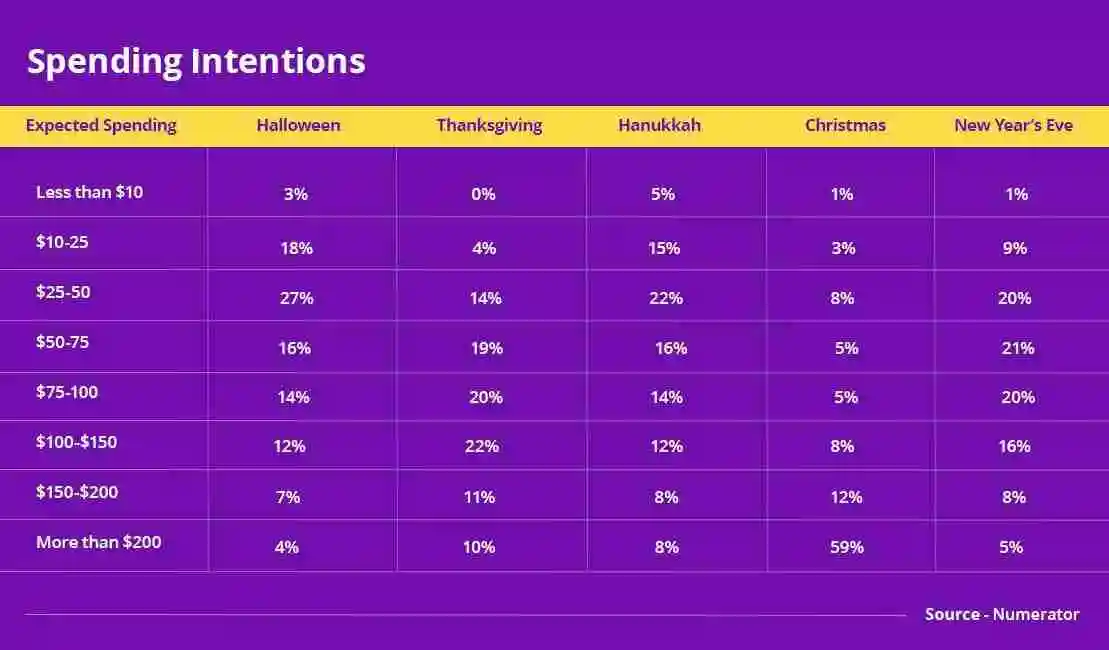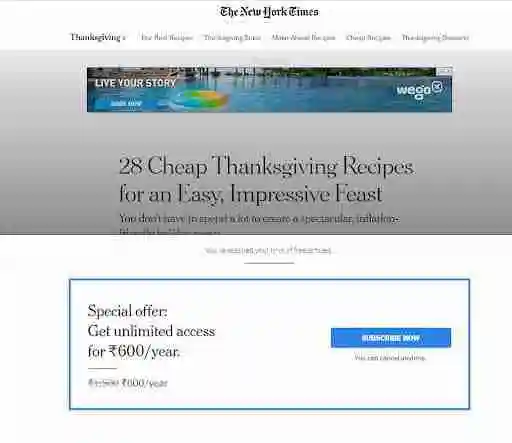The winter holiday season of 2022 has begun and is all set to bring a positive cash flow in the market. Thanksgiving is the festival of gratitude and love, and this year, around 97% of U.S. citizens are ready to savour and celebrate the goodness of the festival with their loved ones. A survey by National Retail Federation found that as many as 62% of respondents are ready to increase their holiday spending during winter celebrations despite the inflation.
This creates an excellent opportunity for publishers to optimize their content and monetize the surge in traffic during this festive season. However, to capitalize on the benefits, publishers need to have innovative Thanksgiving strategies.
In this post, we will explore prevalent consumer trends and behaviour, how top publishers are tapping into Thanksgiving’s full potential, and what additional strategies publishers can implement to boost their revenue.
Table of Contents
Consumer Trends for Thanksgiving 2022
- Thanksgiving is about expressing gratitude and sharing love with friends and family. Continuing the tradition, this year, people are excited to spend more on the celebration, making online eCommerce sales reach $5.5 billion.

Image Source: eMarketer
- COVID-19 has restricted most Americans from meeting their loved ones in the past few years. However, this year it’s not the same. Numerator, a consumer insights and data company, reports that gathering would be the most popular Thanksgiving activity in 2022. This is followed by cooking, baking, decorating, attending parties, and traveling.
- Thanksgiving is a festival of merriment, good food, and gatherings. Hence, it is no surprise that the most popular purchased products this Thanksgiving would be food, alcohol, beverages, and decorations.
- This year, the expected spending intention of each customer has also increased, with 22% of Americans willing to spend around $100 to $150 during Thanksgiving.

Image Source: Numerator
Thanksgiving Strategies to Learn From Top Publishers
The New York Times’ Cooking
The New York Times is a prominent name in the news publishing sector, catering to millions of readers across the globe with its broad range of informative content since 1996.
Though there are several growth strategies that publishers can learn from The NYTimes, the publisher takes different measures to attract audience and advertisers during Thanksgiving. It has a dedicated landing page for Thanksgiving recipes on its cooking website, being run since 2017. The publisher also promotes individual Thanksgiving newsletters to cater to the consumers’ specific needs during the holiday season.
However, unlike other similar recipe-based websites, The New York Times Cooking is a subscription service of the publisher. For many competitors, the idea of putting such content behind a paywall was considered risky when the publisher launched Cooking in 2017. However, The New York Times was confident that its subscription-based strategy would pay dividends, and so it did. By 2018 almost 120k people had already subscribed to the dedicated cooking vertical.

Image Source: The New York Times
Now the question is how does the publisher monetize the Thanksgiving traffic with ads? The strategy involves both direct sales and programmatic advertising. They have diversified their revenue generation channels by experimenting with private marketplace auctions and preferred deals. They further maximize their bid rates, ad relevance, user engagement with ads, and revenues by focusing on Thanksgiving-conscious buyer categories like retail advertisers.
Condé Nast
When it comes to enterprise publishers, there are few as big as Condé Nast. The publisher has several brands, including Epicurious U.S., Bon Appétit U.S., and Condé Nast Traveler. These websites churn out personalized content for their audiences and experience a considerable surge in traffic during Thanksgiving.
The publishing company grouped Epicurious, Bon Appétit, and Gourmet under Food Innovation Group to provide a one-stop-shop for its advertisers. It monetizes the traffic coming to the website through direct sales and programmatic solutions.
Condé Nast provides customized solutions to cater to advertisers and enable them to reach 402 million digital audiences that are relevant. Additionally, the publisher offers sponsored Thanksgiving guides created by top brands on the website.
But that’s not all. Condé Nast has further experimented with cross-platform selling of inventories. This allows buyers to target users across various devices irrespective of whether the user accesses Condé Nast’s website via desktop, tablet, or mobile phone. The publisher took this decision after realizing that a significant portion of its audience accesses its websites using various platforms/devices.
Allrecipes
Allrecipes is part of Dotdash Meredith – the most prominent digital and print publisher in America. Millions of users visit Allrecipes to find their favorite recipes.
The publisher creates unique content, including videos and guides around the theme of Thanksgiving, to bring more search traffic. This creates the scope for contextual advertising, attracting relevant brands willing to advertise around such content. The publisher leverages analytical tools like Chartbeat, Tableau, and DMPs (e.g., Bluekai and Adobe Audience Manager) to collect and store first-party data in its database. Further, it enables the advertisers (that have CPG – Consumer Packaged Goods model) to identify the relevant users.
The publisher also understands how vital first-party data is in a world that will soon make third-party cookies a thing of the past. Hence, they collect new users’ demographic details and other first-party credentials to enrich their first-party database. This helps with advanced targeting capabilities that attract buyers and lure them in with the campaign tracking capabilities to monitor a user’s path to purchase. Allrecipes also offers custom ad solutions like sponsorships, native ads, and video ads.
4 Thanksgiving Strategies for Publishers
Create Optimized Content for Thanksgiving
Content plays a decisive role in acquiring and retaining quality readers. The higher the traffic, the higher the chances of potential conversions and increased revenues. Thanksgiving is no different. In fact, as per trends, content consumption increases during the festival season, with more readers looking out for the perfect recipes, best gifts, or lovely decoration ideas.
This increased traffic gives publishers the golden opportunity to meet their revenue goals with optimized content. Many users search for niche content around Thanksgiving, looking for gift ideas or travel destinations at least two months prior. Publishers can use this opportunity to increase revenue by publishing content at least ninety days before the festival.
Thanksgiving content also creates the scope for running contextual ads. An IAS survey reveals that 32% of users think ads are helpful when relevant to the content context. They are known to increase user experience, CTRs, user engagement with ads, and revenues for publishers. At the same time, buyers find them attractive because they increase ad relevance and chances of successful conversions. Therefore, creating content around the right keywords and serving contextual ads on the pages is the right foot forward for publishers.
Publishers can also generate revenue through direct deals by publishing affiliate content. They can use their niche audience base and unique content to attract interested advertisers. Affiliate content can be further refined by creating evergreen pieces like “Top 10 gifts for men on Thanksgiving” or “Most essential food items to buy during Thanksgiving” while cutting affiliate deals with the product brands they recommend.
Start With Programmatic Ads and PMP Deals
Today, almost every major publisher monetizes the website with programmatic ads. eMarketer predicts that around $123.22 billion will be spent by U.S. advertisers on programmatic display ads in 2022. So, if publishers haven’t started with programmatic, it’s high time to try it.
Apart from open market programmatic auctions, publishers can also attract direct demand by experimenting with PMP deals. These deals include programmatic offerings like private auctions, preferred deals, and programmatic direct.
Private marketplaces are an excellent option for both publishers and buyers. Being transparent and having a significant degree of control, publishers can effectively promote premium inventories through such deals. At the same time, buyers can ensure that their ads are shown to their ideal audiences. Publishers also enjoy higher CPMs.
Win User Attention on Different Channels
With content being available across multiple channels and devices, consumer attention has been more fragmented. Advertisers constantly look towards engaging holiday shoppers across multiple devices and screens. Publishers must, therefore, strive towards improving efficiency and performance to make this possible for buyers.
Publishers can create audience segments based on devices or genres and help buyers reach holiday-specific audiences by offering them curated inventories to target. This can also allow them to declare premium inventories and maximize revenues.
Another way to ensure efficiency is by gathering advertisers’ trust, allowing them to invest in a publisher’s inventories with utmost confidence. This can only be achieved by striving for transparency. Implementing industry standards accurately, complying with regulations, and adopting solutions like ads.txt and sellers.json is crucial.
Experiment With Different Ad Formats and Sizes
According to Taboola’s survey, mobile and tablet have almost the same demand among advertisers. The graph below shows that mobile users’ CTR is higher than tablets and desktops. However, the conversion rate is comparatively higher for tablet users than for mobile and desktop users. Thus, publishers must not overlook mobile and tablet users if they want to maximize revenue.

However, the problem is that not all ad formats and sizes are perfect for all devices. Hence publishers need to experiment with various ad formats and sizes. They need different ad sizes for the same inventory but optimized for different devices. This would ensure maximized yield, fill rate, and demand and increase revenues. Experimenting with various ad placements or sizes responsive to mobile screens, rich media ads, or high-impact display and video ads would drive the highest engagement rates, viewability, and revenue for any publisher.
What’s Next?
The prevalent shopping trends and the rise of digital footprint during the holiday season bring good news for the publishers, despite inflation. Big publishers like The New York Times and Condé Nast have already begun their Thanksgiving campaigns and are reaping good results.
Publishers should start experimenting with these strategies to benefit from the increased ad spend. The successful implementation of carefully selected strategies and data-driven business optimizations will help publishers make the most of this Thanksgiving weekend.























